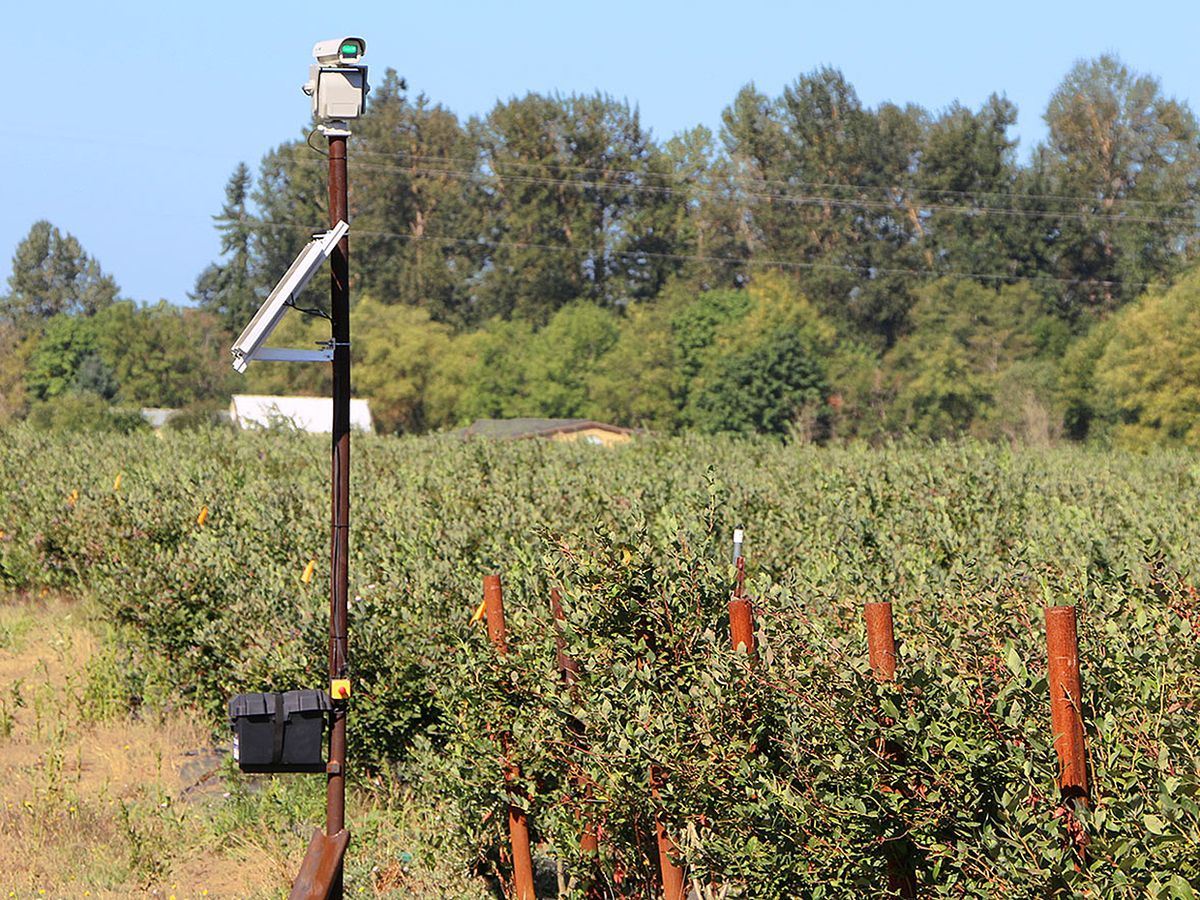Last summer, a blueberry farm in Oregon was desperate to solve its bird problem. The year before, the farm had lost more blueberries to hungry birds than in any previous growing season, with robins and starlings devouring 25 percent of its crop.
At the start of this year’s growing season, the 168-acre farm installed six Agrilaser Autonomics—which are automated laser guns mounted on a pedestal—and aimed them at its blueberry bushes. The devices shoot a steady green laser beam that sweeps across the bushes from side to side. Birds seem to mistake the sweep of the laser for a predator’s approach, and take flight whenever it comes near.
Bird Control Group, the company that manufactures the lasers, says the devices have reduced the number of birds on the blueberry farm by 99 percent, from an average of 1,500 birds to just a handful. The farm estimates it has saved about 262,500 kilograms (578,713 pounds) of blueberries, worth US $99,733, as a result.
That is magnificent success even by his own standards, says Steinar Henskes, CEO of Bird Control Group. Customers who install Agrilaser Autonomics typically see a reduction in birds of between 70 to 99 percent.
It took his company about four years to develop the laser, after testing various colors, wavelengths, and beam widths. They settled on a wide, green beam and applied filters that reduce harmful infrared radiation. “We learned the characteristics of what we call the ultimate laser beam for dispersing birds,” Henskes says.

Why green? “We researched the color that sends the most amount of signals from the birds’ eye to the brain, so it’s perceived as more intense,” Henskes says. “It’s roughly eight times more effective than red, for example.”
Part of their secret sauce also rests in the sweep pattern of the laser. Henskes says the company, which now has 30 employees, tested many patterns and found that some are more effective than others at flushing out birds. Now, they customize and program the laser’s pattern for each site.
Agrilasers now operate at farms around the world, including an organic blueberry research farm at Oregon State University. They’re also shooing geese from airports and spooking seagulls from oil rigs. In fact, the laser technology is in use at more than 6,000 facilities worldwide, discouraging birds from alighting on food processing plants and on fishing boats.
The solar-powered laser guns cost about $10,000 apiece and most facilities need more than one. “Over the years, we’ve learned that overlap is important because if we just used one system, we’d just herd the birds around,” Henskes says. Farms generally operate the guns on a schedule, firing up at dawn and dusk during typical feeding times. A fishing boat, however, might leave them on all the time.
For now, the lasers operate blindly based on programmed instructions—they can’t target specific birds or turn themselves on when a bird comes by. In future versions, Henskes says he hopes to add detection capabilities based on radar and cameras, and a feature that would allow the farmer or Henskes’ team to remotely control the laser pattern and pulse.
Lasers do not work on every bird. There are more than 12,000 bird species in the world, and Bird Control Group has not tested its technology on all of them. But the company has found that it tends to work best on birds that have natural predators. Birds that are predators, such as hawks and falcons, aren’t really bothered by it.
Birds don’t seem to grow accustomed to the lasers like they do to scarecrows and other common deterrents. Henskes points to a dairy processing facility in the Netherlands where Agrilasers were first installed in January 2014. After several years, birds still responded to it. When the light source eventually needed replacing, birds returned while the laser was down. And once it was back up, the birds disappeared again.
Lasers are already used to fry lice off the backs of farm-raised salmon and detect and trap feral cats. But Bradley Blackwell, a research wildlife biologist for the U.S. Department of Agriculture who studies the sensory systems of animals, says there isn’t yet enough research to guarantee that laser-based bird deterrent systems aren’t causing unintended harm.
“We know very little about how the power, beam characteristics, and wavelengths affect the visual system of birds, across bird species, or other species,” he says. “Are we doing damage to the vision of these animals? What power levels and wavelengths will suffice for dispersal results, but pose no injury? Currently, we do not know the answers.”
Blackwell and Esteban Fernandez-Juricic of Purdue University are currently studying these systems and hope to have some of these answers soon. But for now, he says he doesn’t recommend the systems. “I have worked with lasers in the past, and I’ve come to learn that we do not understand enough about potential effects on the visual systems of target species to assume that there is no risk,” he says.



